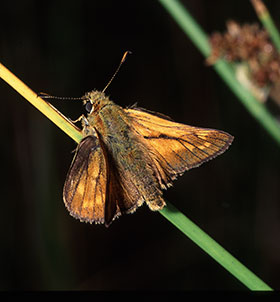Large Skipper (Ochlodes venata)
When: Early June to late August
How many: Common and widespread

in the sunshine
Despite the name, the Large Skipper is quite a small insect with a wingspan that measures a mere 3.5 centimetres, or thereabouts.
As with all the skipper clan, Large Skippers can appear almost moth-like; whilst in common with certain other members of the tribe, when basking and feeding they habitually hold their forewings aloft and their hindwings in a more horizontal position.
Although featuring much brown colouration, bright orange patches provide a splash of contrast, whilst black veins contribute to the creation of a quite distinctive pattern that helps separate Large Skippers from the closely related, superficially similar, small skippers and Essex skippers, both of which fly at around the same time and, despite the latter's name, occur in the New Forest. Males and females are similarly, though not identically, coloured and marked.
Woodland edges, rides and clearings provide favoured living space, particularly if caterpillar foodplants - coarse grasses - are present together with brambles or other nectaring flowers.
Large Skippers can be seen on the wing from early June until late August, but, in common with many other butterflies, sunshine is needed to encourage significant activity.
References:
Butterflies of the British Isles: J.A. Thomas
The Butterflies of Hampshire: Matthew Oates, John Taverner, David Green et al
The Millennium Atlas of Butterflies in Britain and Ireland: Jim Asher, Martin Warren, Richard Fox, Paul Harding, Gail Jeffcoate and Stephen Jeffcoate
Insects of the New Forest - Paul Brock
More links
Other related links
Search this site

Sadly, 58 animals were killed - 35 ponies, 13 cows, 8 donkeys and 2 sheep, whilst a further 32 were injured - 3 pigs, 9 donkeys, 11 cows and 9 ponies.
(Forty-three accidents occurred in daylight, 15 at twilight and 101 in the dark. Twenty-seven accidents were not reported by the driver involved).
Here's just one horrific example - Three donkeys killed in collision with van at notorious New Forest blackspot (Advertiser and Times)

